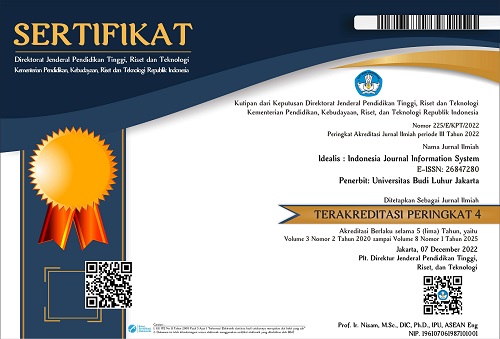ANALISIS SENTIMEN PADA MEDIA SOSIAL TERHADAP LAYANAN SAMSAT DIGITAL NASIONAL DENGAN SUPPORT VECTOR MACHINE
DOI:
https://doi.org/10.36080/idealis.v8i1.3276Keywords:
text mining, CRISP-DM, sentiment analysis, signalAbstract
Motor vehicle users experience rapid growth every year. The increasing number of vehicles contributes to one of the state revenues: taxes. SAMSAT is a state institution with the authority to regulate motor vehicle tax (PKB). As technology develops, SAMSAT innovates through the SIGNAL application, which allows people to make motor vehicle tax payments safely via cell phone. Social media such as Instagram and X have great potential for collecting data to understand public reactions to the SIGNAL application. Comments on social media regarding the SIGNAL application raise pros and cons from the public; therefore, it is necessary to carry out sentiment analysis through a text mining approach using the Support Vector Machine (SVM) algorithm following the Cross Industry Standard Process for Data Mining (CRISP-DM) methodology. This research was carried out through several stages: data collection, preprocessing, modeling with the Support Vector Machine (SVM), and evaluation with a confusion matrix. Data in the research were collected from Instagram social media comments from September 20, 2023, until. 16 April 2024 as many as 3,543 records and 1,335 comments on X's social media from 31 May 2023 until March 27, 2024, with the keyword "SIGNAL application". After the preprocessing stage, the data used was reduced to 3,911 because there were duplicate and irrelevant reviews. based on 3,911 data, it produced 773 positive comments, 1991 negative, and 1147 neutral comments. This research aims to identify public sentiment towards SIGNAL services via social media, such as Instagram. We prepared a dataset of two and three sentiment classes for research modeling needs. Based on the application of the model, a Support Vector Machine (SVM) with a linear kernel produces better scores than the Naïve Bayes and KNN models with accuracy values of 0.88, precision of 0.88, recall of 0.81, and AUC of 0.92 using a 10-fold cross-validation on training data and test data.
Downloads
References
B. P. Statistik, “Perkembangan Jumlah Kendaraan Bermotor Menurut Jenis (Unit), 2021-2022,” 2024. https://www.bps.go.id/id/statistics-table/2/NTcjMg==/perkembangan-jumlah-kendaraan-bermotor-menurut-jenis--unit-.html (accessed Mar. 20, 2024).
S. D. Nasional, “Mengapa Bayar Pajak Kendaraan Bermotor?,” 2021. https://samsatdigital.id/artikel/mengapa-bayar-pajak-kendaraan-bermotor (accessed Mar. 20, 2024).
D. Wijaya, R. A. Saputra, and F. Irwiensyah, “Analisis Sentimen Ulasan Aplikasi Samsat Digital Nasional Pada Google Playstore Menggunakan Algoritma Naïve Bayes,” KLIK Kaji. Ilm. Inform. dan Komput., vol. 4, no. 4, pp. 2369–2380, 2024, doi: 10.30865/klik.v4i4.1738.
R. A. Putra and W. Pramusinto, “Sentimen Tweet Pada Elektabilitas Bakal Calon Presiden 2024 Implementation K-Nearest Neighbor ( Knn ) Sentiment Analysis Of 2024 Presidential Candidates ’ Electability,” vol. 2, no. September 2023, pp. 985–994, 2024.
S. Kacung, B. C. P. Putra, and D. Cahyono, “Analisis sentimen terhadap layanan samsat digital nasional (signal) menggunakan metode svm 1,2,3,” MNEMONIC, vol. 7, no. 1, pp. 118–122, 2024.
A. P. Giovani, A. Ardiansyah, T. Haryanti, L. Kurniawati, and W. Gata, “Analisis Sentimen Aplikasi Ruang Guru Di Twitter Menggunakan Algoritma Klasifikasi,” TEKNOINFO, vol. 14, no. 2, pp. 116–124, 2020, doi: 10.33365/jti.v14i2.679.
S. Mahendra and S. Syofian, “Penggunaan Algoritma Support Vector Machine (SVM) untuk Menganalisis Sentimen dari Ulasan Pelanggan Terhadap Layanan Kurir J&T Express di Google Play Store,” J. Sains Teknol. , vol. 13, no. 2, pp. 29–36, 2023, [Online]. Available: https://unsada.e-journal.id/jst/article/view/450
Y. Findawati and M. A. Rosid, Buku Ajar Text Mining. Sidoarjo, Jawa TImur: UMSIDA Press, 2020.
P. Arsi and R. Waluyo, “Analisis Sentimen Wacana Pemindahan Ibu Kota Indonesia Menggunakan Algoritma Support Vector Machine ( SVM ) Sentiment Analysis On The Discussion Of Relocating I Ndonesia ’ S Capital City Using The Support Vector Machine ( SVM ),” J. Teknol. Inf. dan Ilmu Komput., vol. 8, no. 1, pp. 147–156, 2021, doi: 10.25126/jtiik.202183944.
T. A. Prasetiarini, I. Ernawati, and N. Chamidah, “Analisis Sentimen Media Sosial Twitter Terhadap Maskapai Penerbangan PT Garuda Indonesia (Persero) Tbk Menggunakan Metode Support Vector Machine (SVM),” Semin. Nas. Mhs. Ilmu Komput. dan Apl., vol. 1, no. 2, pp. 637–646, 2020.
R. Darmawan and S. Amini, “Perbandingan Hasil Sentimen Analysis Menggunakan Algoritma Naïve Bayes dan K-Nearest Neighbor pada Twitter Comparison of Sentiment Analysis Results Using Naïve Bayes and K-Nearest Neighbor Algorithm on Twitter,” Semin. Nas. Mhs. Fak. Teknol. Inf. Jakarta-Indonesia, no. September, pp. 495–501, 2022, [Online]. Available: https://senafti.budiluhur.ac.id/index.php/
R. A. Fauzianto and Supatman, “Analisis Sentimen Opini Masyarakat Terhadap Tech Winter Pada Twitter Menggunakan Natural Language Processing,” J. Syntax Admiration, vol. 4, no. 9, pp. 1577–1585, 2023, doi: 10.46799/jsa.v3i9.909.
V. K. S. Que, A. Iriani, and H. D. Purnomo, “Analisis Sentimen Transportasi Online Menggunakan Support Vector Machine Berbasis Particle Swarm Optimization,” J. Nas. Tek. Elektro dan Teknol. Inf., vol. 9, no. 2, pp. 162–170, 2020, doi: 10.22146/jnteti.v9i2.102.
E. P. Sutrisno and S. Amini, “Implementasi Algoritma K-Nearest Neighbor Pada Implementation Of K-Nearest Neighbor Algorithm In Sentiment Analysis Of User Reviews For Digital,” SENAFTI, vol. 2, pp. 687–695, 2023.
A. D. A. Putra and S. Juanita, “Analisis Sentimen pada Ulasan pengguna Aplikasi Bibit Dan Bareksa dengan Algoritma KNN,” JATISI (Jurnal Tek. Inform. dan Sist. Informasi), vol. 8, no. 2, pp. 636–646, 2021, doi: 10.35957/jatisi.v8i2.962.
R. Kosasih and A. Alberto, “Analisis Sentimen Produk Permainan Menggunakan Metode TF-IDF Dan Algoritma K-Nearest Neighbor,” InfoTekJar J. Nas. Inform. dan Teknol. Jar., vol. 6, no. 1, pp. 134–139, 2021, [Online]. Available: https://doi.org/10.30743/infotekjar.v6i1.3893
J. Adiputra and D. Mahdiana, “Analisis Sentimen Dengan Algoritma Support Vector,” Indones. J. Inf. Syst., vol. 6, no. April 2022, pp. 1–8, 2023.




.png)














